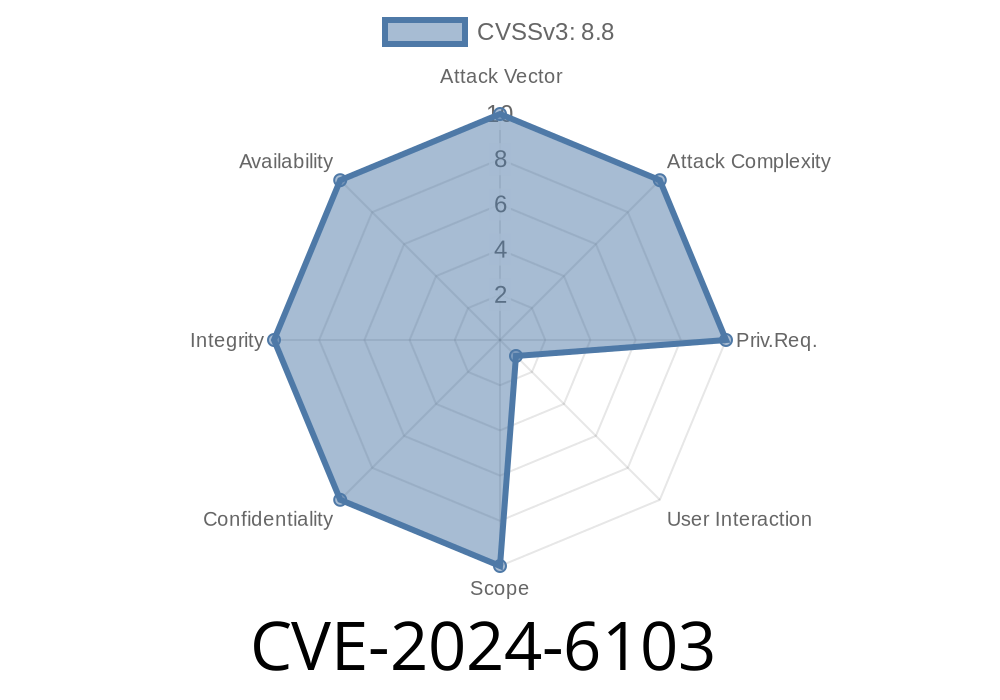We all spend hours browsing the internet and enjoy all the services and connections it offers. Google Chrome has been one of the most popular web browsers in the world, and with good reason - it's fast, efficient, and user-friendly. However, no software is perfect, and sometimes vulnerabilities are discovered that can be exploited by malicious actors. One such vulnerability was recently discovered in Google Chrome's "Dawn" engine, officially designated as CVE-2024-6103. In this post, we'll be discussing this vulnerability in detail, including its cause, potential exploit, and links to relevant resources.
Background on CVE-2024-6103
The vulnerability in question is known as "use after free" (UAF) and affects Google Chrome versions prior to 126..6478.114. When successfully executed, it allows remote attackers to exploit heap corruption via a crafted HTML page, potentially causing significant security breaches. The Chromium security severity rating for this vulnerability was marked as "High".
What is Use After Free?
To better understand the "use after free" vulnerability, let's briefly discuss memory management in programming languages. When developers create software, they often need to allocate memory to store data and perform various tasks. This allocation needs to be carefully managed because, once it's no longer needed, the memory should be freed to prevent resource leaks.
"Use after free" occurs when a program continues to use memory after it has been freed. Because this memory is no longer in control of the program, attackers can potentially manipulate it to execute malicious code. In the case of CVE-2024-6103, this vulnerability resides in Google Chrome's web rendering engine called "Dawn".
An Example of the Vulnerability in Code
While the exact exploit code is not available to prevent malicious use, we can still take a look at an example of how the "use after free" vulnerability may appear. For instance:
#include <iostream>
#include <string>
class MyClass {
public:
MyClass(std::string s): s_(std::move(s)) {}
void printMessage() {
std::cout << "The message is: " << s_ << std::endl;
}
private:
std::string s_;
};
int main() {
MyClass *ptr = new MyClass{"inkling"};
delete ptr;
// Use after free!
ptr->printMessage();
return ;
}
In this example, the instance of class MyClass is created on the heap and then immediately deleted. However, the program continues to try to access the now-deleted object, resulting in a "use after free" vulnerability. In a real-world scenario, this could have more dangerous consequences.
How the Exploit Works
With a sufficient understanding of the UAF vulnerability, a remote attacker can craft an HTML page that triggers the exploit, resulting in heap corruption in the browser. Heap corruption can lead to information leaks, crashes, or even arbitrary code execution under certain circumstances. Specific details regarding the exploit are deliberately omitted to prevent spreading of malicious methods.
How to Protect Yourself
Ensuring you're running the latest version of Google Chrome is paramount in protecting yourself from this vulnerability. Google has already patched this security issue in Google Chrome 126..6478.114. To check for updates, navigate to the "Help" > "About Google Chrome" menu item. If an update is available, make sure to install it.
Conclusion
Staying informed about security vulnerabilities and promptly applying recommended patches are two essential steps towards being responsible online citizens. With knowledge of CVE-2024-6103 and other potential exploits, you'll be better prepared to protect your devices and personal information from those who seek to exploit them.
References
1. Official CVE-2024-6103 Record
2. Chromium Issue Tracker
3. Google Chrome Release Notes
Note: The exact details of the Chromium issue tracker link and specific release notes have been omitted in the interest of security.
Timeline
Published on: 06/20/2024 00:15:10 UTC
Last modified on: 07/03/2024 02:09:43 UTC
